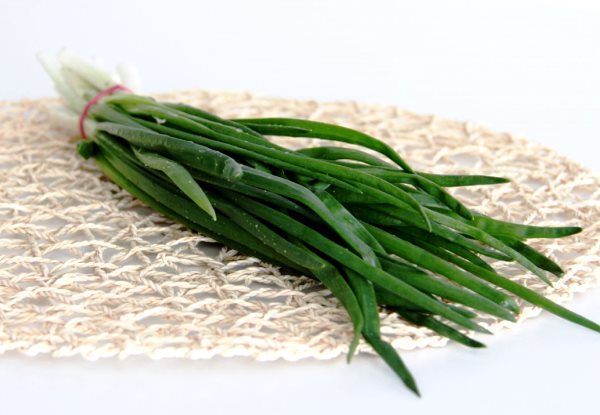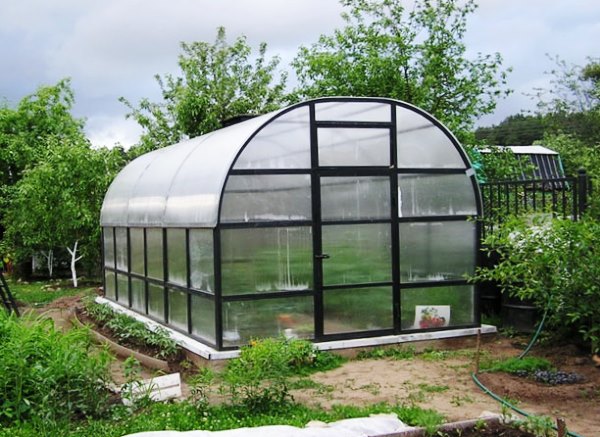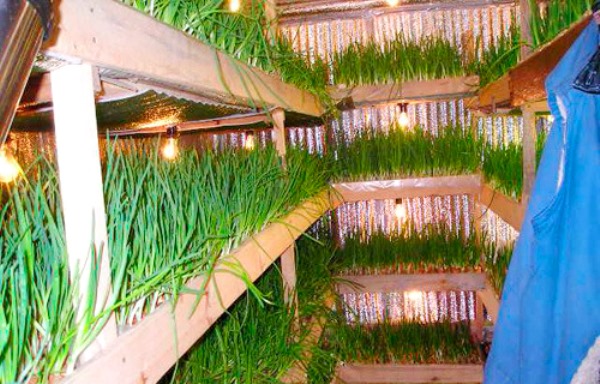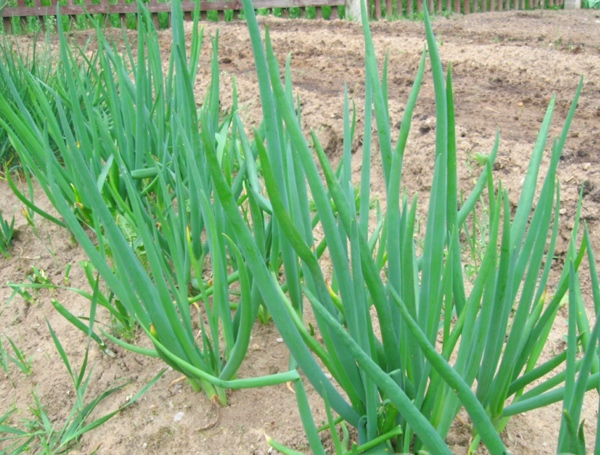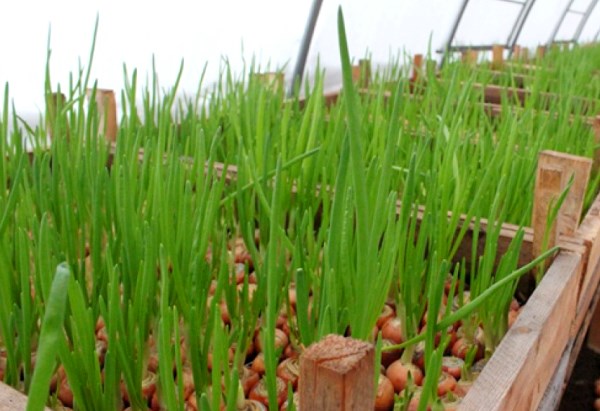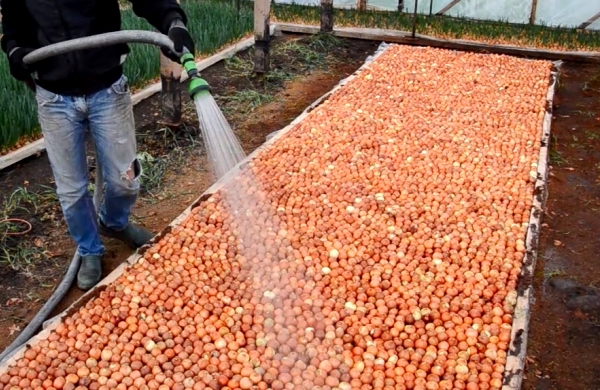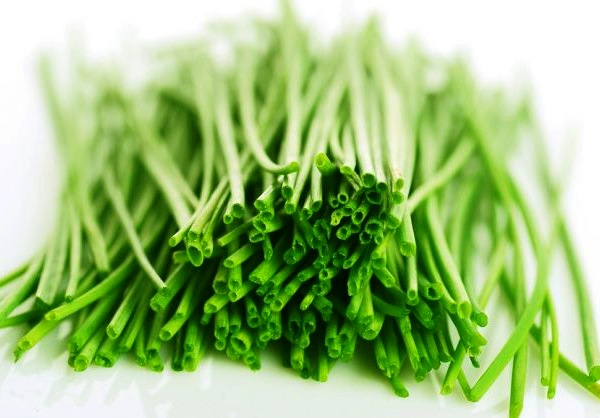Greens all year round - we grow onions in a greenhouse all year round
Greens, especially onions, are a beautiful ingredient in any dish: on New Year's, it turns into a Christmas tree, and by March 8 it becomes tulip stalks, they are tied to the favorite “bags” of pancakes and meat filling. In a word, this plant becomes an indispensable helper for housewives. In order for it to please all year round, it is necessary to grow onions for greens in a greenhouse.
Green onions have the ability to improve digestion and the process of assimilating the food taken with it. This is not the whole list of the positive effects of this vegetable on the body, but without even knowing it, it becomes clear that people want to grow green onions both in winter and in summer.
Greens are a product that is relevant and in demand at any time of the year, but at the same time it is unpretentious in greenhouse cultivation.
If in the summer with planting everything is much easier - you can plant it on a personal plot, then in winter you will need a greenhouse to get a crop.
Content
Greenhouse requirements
For growing onions in a greenhouse, structures made of various materials are used:
- polycarbonate;
- glass;
- film.
The choice of coverage most often rests on finances. The cheapest option is film, but it should be borne in mind that it will need to be replaced every year, so is it that cheap? On the other hand, saving on covering in the first year will make it possible to purchase the necessary tools and equip the premises. One of the inconveniences in this coating is the annual assembly / disassembly.
In the long term, growing green onions in a greenhouse will be the best material for polycarbonate. The main advantages of this material:
- reduction of heat loss, which means a decrease in heating costs;
- decent strength;
- durability of the structure.
As for the site, it must be protected from the wind, the best location is south.
The greenhouse must be equipped with the following:
- an efficient heating system if you plan to land for the winter;
- lighting system (preferably vertical lamps);
- boxes with soil or beds.
Where to plant? There are several options. It can be planted directly into the ground, but in this way there is an irrational use of the area. The best option would be - the construction of shelving. In addition, racks save the gardener from several tasks:
- on the shelves, the soil warms up faster, as a result - the growth period is reduced by 12-15 days on average;
- the construction of shelving relieves a person from the need to bend his back and crawl on his knees;
- watering plants will require less water, and this is already saving;
- when constructing multi-tiered racks, the landing area is automatically increased.
When equipping shelving, do not forget to use last year's film, lay it on the base and pour earth into it.
Be sure to arrange heating, especially along those walls of the greenhouse that will not be exposed to sunlight.
By and large, the greenhouse is now ready.
Which variety should you choose?
Growing onions for greens in a greenhouse is quite a profitable business, but in order to get a good harvest, you need not only to create conditions for the plant to grow, but also to choose the right variety.It should be noted that there are several types of onions grown for greens:
- onion;
- batun;
- slime;
- chives;
- tiered bow.
Batun onion. This plant belongs to the category of perennials. The yield period lasts from early spring to late autumn. Its peculiarity is that it does not form bulbs. The greens of this plant are similar to those of onions. It tolerates winter well. It is better to start planting it in December.
In this species, the following are considered the best varieties:
- Gribovsky-21;
- Salad-35;
- Local Ural;
- Maisky 7
Slime. The plant is milder in taste than onions and has a garlic aroma. It tolerates cold and frost well, loves humidity. Planting of this species can be done at any time of the year - this is its advantage.
Schnitt. This species is also perennial, but is more suitable for open ground, since it is frost-resistant.
The best varieties:
- Pink K-1669;
- Siberian K-1670.
Multi-tiered onions are the most suitable species for growing in the autumn-winter period in a greenhouse. The best varieties: Gribovsky-38, Odessa winter 12.
Onion. Most often, gardeners choose this particular species for growing greens in a greenhouse. Multi-leaf varieties are selected that are able to form more leaves.
The best varieties of this type:
- Stuttgarter Riesen;
- Strigunovsky local;
- Bessonovsky fruitful;
- Danilovsky 301
Planting and leaving
Onions are grown in the greenhouse all year round, but it is best to grow them from October to May. The soil is prepared in advance, it must be fertile and loose. Almost all crops love fertilized soil. Before planting, it is advised to add the following fertilizer to the soil mixture, the calculation is per 1 sq. M.:
- manure - 1 bucket;
- superphosphate - 30g;
- potassium chloride - 15g.
Onions in the greenhouse are planted in three ways: using heads, seeds or seedlings.
Seedlings are planted in early March. Initially, the seeds are prepared: they are soaked either for three days in water at room temperature, or placed in water at a temperature of + 40 ° C for 8 hours. Next, the seeds are sown in prepared containers. Seedlings can be planted in the greenhouse no earlier than two months after germination.
Each type of onion has its own planting technology.
So, the onion can be grown by seedlings and seeds, starting in December. Sowing is carried out densely: 3g is used per 1 sq.m. plot. Using the seedling method, grow five plants in a container, which are then planted in such groups at a distance of 15 cm from each other. For the purpose of one-year distillation, when harvesting, the green leaves are pulled out together with the underdeveloped bulb, otherwise, only greens are cut off. It should be noted that three-year-old bulbs are fertile.
Slime onions are grown in three ways: by dividing the bulbs, by seeds or seedlings. After planting any type of onion, it must be watered with warm water.
Onions are grown in the greenhouse from the end of November. In this case, the crop can be harvested after 30 days. The secret of the delicious greenery of this plant is precisely in the planting - the soil for planting should be with neutral acidity, as well as sufficiently moist. We can say that this species is quite fertile, it can yield up to 5 crops per season.
Onion care is quite simple, this plant is not demanding. All you need is:
- feed the plant 1 time during the entire growth period, using a solution of ammonium nitrate at the rate of 30 g per bucket of water;
- abundant watering, onions are very fond of water;
- control the level of soil moisture, prevent the bulb from rotting;
- observe the temperature regime, especially in winter (not lower than + 19 ° С during the day and not less than + 12 ° С at night);
- prevent drafts in the greenhouse;
- prevent plant diseases (onion mosaic, black mold, onion fly, tobacco thrips, etc.)
Experienced gardeners say that if the onion is fed a week after planting, and then 10 days after the first feeding, it will yield much more harvest. The following mixture is offered as fertilizer:
- water - 1 bucket;
- ammonium nitrate - 15-20g;
- superphosphate - 30g;
- potassium chloride - 15-20g.
Green onions in the greenhouse must be cut on time. The average is a leaf length of 30 cm.
Features of growing for sale
The main secret in growing onions for sale is the correct choice of planting material. Selection rules that should be followed to obtain a successful result:
- it is worth choosing early or mid-season varieties;
- for sprouting onions for greens for the purpose of subsequent sale, the best sevok is (two-year-old);
- it is unacceptable to plant onions with an open "neck", such a vegetable affects rot;
- if the buds of the roots of the bulb are already swollen, this material is very good for planting;
- when growing onions for sale, it is better to equip the greenhouse with multi-tiered racks, thereby increasing the planting area.
- if germination will come from different "lots" and varieties, then it is better to check the growth rate in order to avoid an extra crop that will be lost.
Forcing green onions is a fairly profitable investment that will bring profit ten times more.
Video "Growing green onions in a greenhouse, part 1"
This video describes the main points of running a greenhouse for the cultivation of green onions for sale.
Video "Growing green onions in a greenhouse, part 2"
In this video, the continuation of the theme "Growing greens in a greenhouse": the main difficulties, specificity, advice on care.

